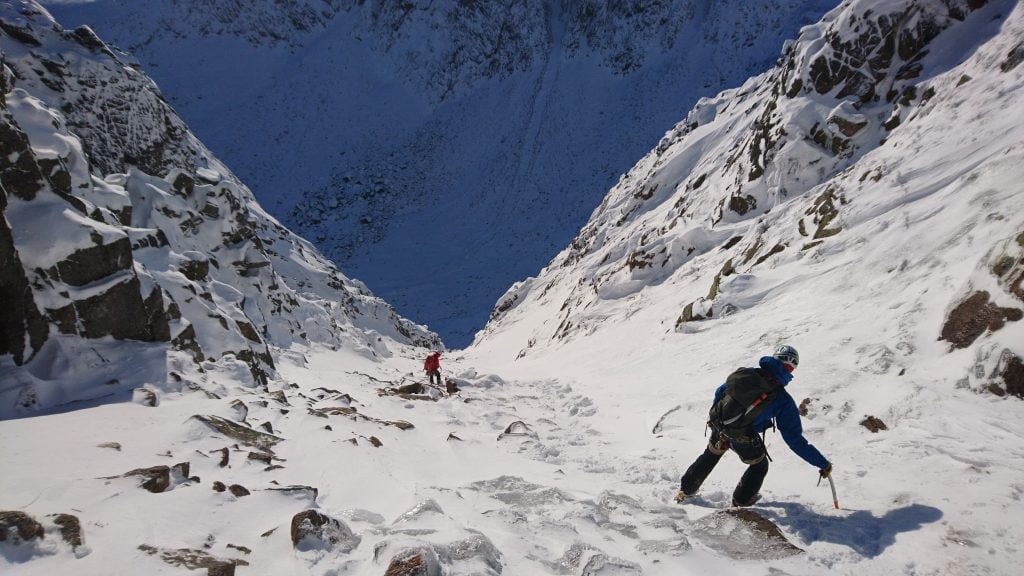Top tips & Skills for Walking in Winter
Below we are going to outline some of the top tips and skills for walking in winter conditions. These tips especially apply to Scottish winters as that is where we are based – that being said, they will apply to many other places in the world.
Take the correct clothing
It goes without saying that winter can be cold – especially so in Scotland. You will need to ensure that you take with you enough clothing that is of decent quality. Thermals are great; mid layers and a good warm jacket are essential as well. Down is warm but if it gets wet it is ruined so Hydro Down or Primaloft synthetic materials are more appropriate. The most important of all are Waterproofs capable of handling the conditions thrown at you. Don’t just buy any cheap old pair – you will regret it. When it comes to waterproofs you really do get what you pay for!
Get instruction and guidance
Winter skills training courses provide you first hand with a huge amount of knowledge, skills and top tips on walking & how to manage the conditions in the mountains safely … and you learn the ability to know what to do if things don’t go according to plan!
Pack your rucksack efficiently and well
Packing a rucksack is an absolute art-form. Check out this
article from the BMC where you can learn a lot about what to take and how to pack it well.
Don’t walk too quickly
You will regret it! If you walk too quickly then you will sweat. Then the moment you stop you will get very cold very quickly. This can then cause serious issues – especially if you are miles away from help. It is better to walk slowly and steadily and take longer, than to bomb it up the hill as quickly as possible.
Take plenty of food and drink
In winter you burn more calories – some say as much as 40% extra – so you need to continually refuel and re-hydrate. If you are feeling thirsty then it is probably already too late. It is better to stop regularly for short periods and grab a quick snack and a quick drink than to only stop for lunch.
Take suitable boots, crampons and ice axes.
Make sure you have winter walking boots that are crampon compatible, that you have the right crampons for the boots – and that these have been correctly fitted prior to being out on the hill. There is nothing worse than trying to size a crampon while on a hill freezing in a blizzard! Also make sure you have the appropriate ice axe – you can find out more about ice axes
here.
Ice axe leashes?
This is an acquired taste, but generally speaking leashes are an annoyance for most tasks … on the other hand, sometimes they can be beneficial. So it is a good tip if you have a leash to have a quick removal setup for walking in winter. Maybe you might want to use a bit of cord or tape on the top of the leash to larks foot it to your axe.

Take lots and lots of gloves.
On a normal day on the hill, each of our instructors carry three pairs of gloves. With spare gloves, if one pair freezes solid or gets wet, just swap to the next – and hey presto, you have warm hands again! If you are on exped then take even more. It is worth spending the extra money on good gloves.
Find regular break spots
As stated already, it is a good idea to stop regularly for short periods to eat and drink – to recuperate energy … and just to get out of the conditions if it is windy or blizzardy. If you come across somewhere which has a wee bit of shelter, savour it for a moment before moving on. Alternatively, aim to navigate to shelter-able spots (making sure they are not avalanche prone, of course).
Check the weather, conditions and your group’s ability first.
You should always keep things within your capabilities. Even the most experienced walkers stay indoors if the weather is going to be too dangerous. You should be able to check and know what the avalanche reports mean – in Scotland we use
SAIS. You should also check the weather conditions for the day or days you are heading out and know how they will affect you. You can use MWIS or met office mountain specific forecasts … both are great. In addition, the BAA app is brilliant for planning your day out in the hills.
Know how the wind will affect you.
The wind can be a cruel mistress in winter, blowing snow right in your face – and worse: it can be so strong it can take you off your feet. Having checked the weather, you should know the strength of the wind and gusts. Then relate that back to how it will affect a person on the hill by looking at the Mountaineering Scotland website (which you can find the link to
here).
Know how to navigate in winter and avoid risks.
Navigating in winter is not the same as navigating in summer. And if things go wrong in winter they can really go wrong. Not knowing how to navigate in bad conditions can often end with mountain rescue being called. Winter navigation skills are ones that you really should learn with
professional guidance and instruction.If in any doubt about any of these tops tips or skills for walking in winter, then seek professional advice or book onto
winter skills training courses with one of the many companies who offer them. You would not want to be in a position where you don’t know what to do.If you are interested in walking in winter as a job then why not become an
outdoor instructor?Walking in the mountains in winter is incredible as they are so beautiful … But without the skills and tips you need they can be brutal.








